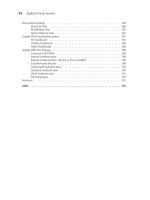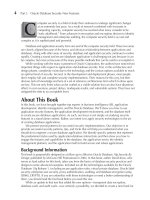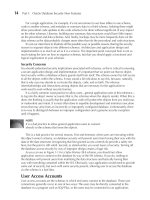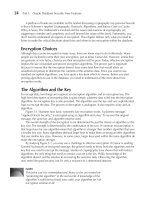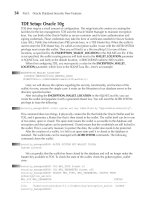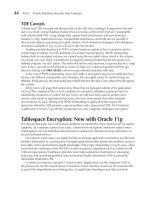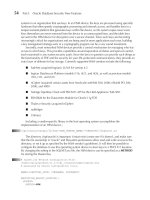oracle fusion middleware patterns
Bạn đang xem bản rút gọn của tài liệu. Xem và tải ngay bản đầy đủ của tài liệu tại đây (10.22 MB, 224 trang )
www.it-ebooks.info
Oracle Fusion Middleware
Patterns
Real-world composite applications using SOA,
BPM, Enterprise 2.0, Business Intelligence,
Identity Management, and Application
Infrastructure
10 unique architecture patterns enabled by Oracle
Fusion Middleware
Harish Gaur
Markus Zirn
BIRMINGHAM - MUMBAI
www.it-ebooks.info
Oracle Fusion Middleware Patterns
Real-world composite applications using SOA, BPM,
Enterprise 2.0, Business Intelligence, Identity Management,
and Application Infrastructure
Copyright © 2010, Oracle and/or its afliates. All rights reserved.
No part of this book may be reproduced, stored in a retrieval system, or transmitted
in any form or by any means, without the prior written permission of the publisher,
except in the case of brief quotations embedded in critical articles or reviews.
Every effort has been made in the preparation of this book to ensure the accuracy
of the information presented. However, the information contained in this book is
sold without warranty, either express or implied. Neither the authors nor Packt
Publishing, and its dealers and distributors will be held liable for any damages
caused or alleged to be caused directly or indirectly by this book.
Packt Publishing has endeavored to provide trademark information about all of the
companies and products mentioned in this book by the appropriate use of capitals.
However, Packt Publishing cannot guarantee the accuracy of this information.
First published: September 2010
Production Reference: 1030910
Published by Packt Publishing Ltd.
32 Lincoln Road
Olton
Birmingham, B27 6PA, UK.
ISBN 978-1-847198-32-7
www.packtpub.com
Cover Image by Sandeep Babu ()
www.it-ebooks.info
Credits
Authors
Harish Gaur
Markus Zirn
Co-Authors
Mike Blackmore
Hamza Jahangir
Basheer Khan
Matjaz B. Juric
Sandeep Banerjie
Srikant Subramaniam
Nikhilesh Chitnis
Kiran Dattani
Milind Pandit
Mark Farabaugh
Sri Ayyeppen
Ross Sharman
Juliana Button
Matt Miller
Mark Simpson
Nam Doan-Huy
Yihong Xu
Narshimha Rao Kondapaka
Melody Wood
John Chung
Rex Thexton
Nishidhdha Shah
Acquisition Editor
James Lumsden
Development Editor
Dhwani Devater
Editorial Team Leader
Gagandeep Singh
Technical Editor
Vinodhan Nair
Indexer
Rekha Nair
Proofreader
Sandra Hopper
Graphics
Nilesh Mohite
Production Coordinator
Kruthika Bangera
Cover Work
Kruthika Bangera
www.it-ebooks.info
Foreword
As you engage in enterprise architecture discussions with your customers, it becomes
very evident that technology decisions are driven by business needs. And to solve
these business needs, customers don't just look for products, they also look for
implementation patterns to create solutions.
Unfortunately, building solutions has traditionally meant stitching together different
technologies from different vendors. This causes issues because businesses innovate
and change faster than ever before. Solutions now need to be delivered in six months
rather than two years and once delivered, they must be exible enough to withstand
ongoing change. Clearly, building exible solutions is hard when exibility gets
locked between a myriad of different technologies and tools.
With Oracle Fusion Middleware Suite 11g, we are revolutionizing the way new
applications are created. Oracle is pioneering a new style of development—we provide
an infrastructure that is complete and integrated. This integrated suite provides the
best SOA, BI, Identity Management, Portal and Content Management tools, each
engineered to work together. Earlier, developers had to build solutions programmed
with thousand lines of code. Now, architects can compose (rather than build) a
solution by combining multiple components of the Oracle Fusion Middleware Suite.
This is exactly how Oracle has crafted its own next-generation Fusion Applications.
This book gives you an understanding of 10 unique patterns to compose solutions
using multiple components of the Oracle Fusion Middleware stack. Every chapter
highlights a unique pattern with its typical business drivers and what the architectural
blueprint looks like. But, we wanted to make this real. That's why every pattern is
backed up by a real-life customer scenario in which the specic pattern has been put
into practice with the help of Oracle Fusion Middleware 11g.
We hope these eld-tested patterns will inspire you to adopt the new "compose
and congure" approach (rather than "build and program") as you create solutions
to address your own business needs.
Hasan Rizvi, Senior Vice President, Oracle Fusion Middleware and Java
www.it-ebooks.info
About the Authors
Harish Gaur is Director of Product Management for Fusion Middleware at Oracle.
In this role, he works closely with strategic customers implementing Service-Oriented
Architecture using Oracle SOA technology. Harish is the co-author of BPEL Cookbook
from Packt Publishing. He holds an engineering degree in Computer Science and an
MBA from Haas School of Business, UC Berkeley. Harish is an author and editor
for this book.
Markus Zirn is Vice President of Product Management for Oracle Fusion
Middleware. He is the editor of BPEL Cookbook, the author of several articles on
SOA and related topics, and a frequent speaker at leading industry and analyst
conferences. He holds a master's degree in Electrical Engineering from the University
of Karlsruhe, Germany, the University of Southampton, U.K., and ESIEE, France.
www.it-ebooks.info
About the Co-Authors
Mike Blackmore, Enterprise Architect at British Telecom, is responsible for
leading the high-level technical relationship between BT and Oracle, engaging
with BT and Oracle teams to make successful product and technology decisions.
Hamza Jahangir is a director of Enterprise Architecture at Oracle, and is
co-author of Applied Oracle Security: Developing Secure Database and
Middleware Environments (McGraw-Hill Osborne Media).
Basheer Khan is an Oracle ACE Director and President and Founder of Irvine,
California-based Innowave Technology. Basheer was named Oracle Magazine's
Integration Architect of the Year 2006 and Oracle Application Users Group (OAUG)
Member of the Year in 2003.
Matjaz B. Juric holds a Ph.D. in computer and information science. He is the
author/co-author of several SOA books, including Business Process Driven SOA using
BPMN and BPEL, Business Process Execution Language for Web Services (English and
French editions), BPEL Cookbook, and SOA Approach to Integration. He has consulted
on several large SOA projects. Matjaz's latest book on WS-BPEL 2.0 for SOA Composite
Applications with Oracle SOA Suite 11g is due out later in the summer.
Sandeep Banerjie is Senior Director of Product Management for Oracle Fusion
Middleware. His responsibilities include developing and executing Fusion
Middleware products and go-to-market strategies for Oracle and non-Oracle
applications across all industries. Sandeep has IT experience of more than 17 years
and is a frequent speaker on ERP, CRM, SCM, SOA, BPM, and Cloud Computing.
Srikant Subramaniam is a product manager for Oracle Fusion Middleware.
He is responsible for enhancing and evangelizing best practices for the middleware
platform as it relates to Oracle applications.
Nikhilesh Chitnis is Senior Sales Consultant for Oracle Fusion Middleware.
He is responsible for positioning and demonstrating the value of Oracle's
Middleware Suite of products to global customers. Nikhilesh has extensive
expertise in the design, development, and implementation of software solutions
across multiple industry domains.
www.it-ebooks.info
Kiran Dattani is Director of Architecture Finance and Procurement for a major
pharmaceutical company, where he is responsible for Global Architecture and
Enterprise Integration projects. An accomplished speaker, he is a recognized
expert in enterprise integration and supply chains in the life sciences and
manufacturing industries.
Milind Pandit is an SOA Architect with Oracle Consulting Services, where he
assists customers in deploying service-oriented architectures. He has 11 years'
experience in software design, development, and implementation involving
Enterprise Application Integration, J2EE, and Object-Oriented Analysis and Design.
Mark Farabaugh is a VP of IT at DJO in Vista, CA, leading DJO's multi-year
program to consolidate all legacy ERP applications to a global single instance of
Oracle EBS R12. Mark has more than 20 years of experience as an IT professional,
and has focused on implementing Oracle enterprise applications such as ERP, BI,
CRM, and FP&A for large multi-national corporations.
Sri Ayyeppen is the co-founder and CTO at Keste, an Oracle Platinum Technology
Partner, where he is responsible for leading teams that deliver complex solutions
with Oracle Applications, Technology, and Infrastructure. Sri was recently
recognized as one of Oracle's Deputy CTOs for the year 2010.
Ross Sharman is the Technical Director for Knowledge Global, where his work
on architecting and building the EMMA sustainability solution helped him to win
the 2009 Green IT Architect Award from Oracle Magazine. Ross has an extensive
background in technology and in electrical and electronic engineering, and has worked
in large integration and Business Intelligence projects in Australia, the US, and Europe.
Juliana Button is Director of Product Management for Oracle Fusion Middleware.
Since 1992, Juliana has held various technical and management positions in Oracle
Corporation in Australia and at Oracle Headquarters in Redwood Shores. Her
responsibilities include showcasing worldwide customer success with Oracle
Application Grid products, as part of the Oracle Fusion Middleware Strategic
Customer Program.
Matt Miller is Applications Director for Europe, Middle East, and Africa at
GroupM. At the time of writing, he was Head of Business Analysts and Testing
at Motability Operations and was also responsible for delivery of the Vehicle
Remarketing technology project detailed in this book. Throughout his career Matt
has worked in a wide variety or technical roles with several large media companies,
including IPC Media, Associated Newspapers, and EMI Music.
www.it-ebooks.info
Mark Simpson is an Oracle ACE Director specializing in SOA and Middleware.
He leads the SOA technology practice for Grifths Waite and is Solution Architect
on Motability Operations Vehicle Remarketing SOA initiative. Mark has been an
advisor on the deployment of SOA solutions at a host of leading organizations in the
UK, and has led implementations based on Oracle Technology, including the rst
production Oracle SOA implementation in the UK and the rst production Oracle
Business Activity Monitoring implementation in the world.
Nam Doan-Huy is a Senior Manager in IT at Wind River Systems, a world leader
in embedded and mobile software. In his role, Nam has responsibility for Oracle
E-Business Suite architecture, Fusion Middleware including SOA, portals, Business
Intelligence, and enterprise databases, supporting a wide range of business units.
Prior to joining Wind River, Nam worked for a number of years in consulting as a
technical lead for ERP implementations.
Yihong Xu, Wind River's Web Architect, has been with Wind River for 10 years.
She started her career as a quality engineer and later switched to working with web
technologies in 2003. As Web Architect, Yihong is responsible for developing web
strategy, including translating business requirements into use cases, identifying
and evaluating tools, selecting hardware and software platforms, and ensuring
coherency across IT's heterogeneous web systems. Yihong has a Masters degree
in Electrical Engineering.
Narshimha Rao Kondapaka is a Project Manager in IT and has been with Wind
River for four years. Rao has more than 11 years of experience working with Oracle
technologies and applications. He began his career as an Oracle Applications technical
developer and switched to become an expert functional Business Analyst. Rao was
recently promoted to Project Manager and played a key role in implementing the
Online Support portal. Rao has a Master's degree in Computer Applications.
Melody Wood is a member of the Fusion Middleware Platform Product
Management team, where she focuses on SOA and Web 2.0 customer deployment
patterns. Melody joined Oracle in 1996, originally holding various partner
management roles, where her increasing technical focus on Oracle product integrations
across the database and middleware product stacks eventually led to her current role.
John Chung is Arcturus Realty Corporation's VP of IT and has over 10 years'
experience in the real-estate industry, with diversied knowledge in technology
and programming covering a broad range of languages and environments.
www.it-ebooks.info
Rex Thexton is a managing director, and is a key leader of PricewaterhouseCoopers'
Security and IdM practice in Oracle environments. Rex is an experienced IT
professional with over 18 years of application development and IT management
expertise. He has a proven track record for implementing strategic projects through a
combination of effective relationship building with business leaders and technological
aptitude. He was named and recognized as one of Oracle's Deputy CTOs, a select
group of practitioners in North America.
Nishidhdha Shah works as senior consultant with PricewaterhouseCoopers. He
has 10 years of experience in security and identity management. He holds CISSP and
CISA credentials since 2006. He won ISC2 Cyber Security Awareness contest 2007 for
his presentation on "Approach to security". Besides Schneider National, he also did a
couple of large-scale OIM and ORM implementation in banking and retail.
www.it-ebooks.info
www.it-ebooks.info
Table of Contents
Preface 1
Chapter 1: Building Agile Applications using Fusion Development
and Oracle Enterprise Architecture Principles 11
Enterprise application development challenges 12
Fusion development 13
Oracle Enterprise Architecture 15
IT rationalization at British Telecom Property Group 17
BT UniApp Framework 18
A quick look inside the UniApp Framework 19
Benets realized by British Telecom 20
Process improvement at Pardee Homes 20
Four steps to Fusion development 21
Summary 24
Chapter 2: Process-driven SOA Development 25
Business Process Management and SOA 25
Organizational aspects of SOA development 27
Technology aspects of SOA development 28
Case study: Process modeling 31
Case study: Process implementation 33
Development of BPEL executable process 34
Development of business services 35
BPMN to BPEL Round-tripping 35
Guidelines on BPMN to BPEL mapping 37
Process execution 39
Process monitoring using BAM and optimizations 39
Summary 41
www.it-ebooks.info
Table of Contents
[ ii ]
Chapter 3: Code-free Application Extensions and Integrations 43
Customer scenario: Travel and expense management 44
Native customization of backend travel and expense
reimbursement system 44
Bolt-on niche application for travel authorization 45
Code-free extension and integration of a backend travel
and expense reimbursement system 45
Programming code-free application extensions and
integrations—the platform 47
E-Business Suite-iExpense 48
Application Development Framework (ADF) 48
SOA Composite 49
WebCenter 49
An MVC approach to creating a composite UI with ADF,
SOA, and JDeveloper 53
Integrating with E-Business Suite using Oracle SOA and Oracle
application adapter 55
Building business logic using Oracle SOA and Oracle Business Rules 58
Building the BI dashboard with Oracle BI Application Spend Analytics 59
Beyond the travel authorization solution—an approach
for other applications 61
Summary 62
Chapter 4: Data Tier Caching for SOA Performance 63
SOA caching strategies 64
Providing a 360-degree customer view 67
Solution using Oracle SOA Suite and Oracle Coherence 67
BPEL: Coherence integration architecture 70
Integrating Oracle BPEL PM with Oracle Coherence 72
Step 1: Create the schema for request and response, and WSDL for the cache service 74
Step 2: Create Java objects from the schemas 75
Step 3: Create the Java implementation class to call Coherence 75
Step 4: Create coherence_cong.xml to congure Coherence 77
Step 5: Package Coherence.jar and Tangosol.jar within BPEL JAR 78
Step 6: Deploy and verify the process 78
Summary 78
Chapter 5: Integrated Real-time Intelligence with Oracle's
WebCenter, Coherence, and Business Activity Monitoring 81
Understanding real-time intelligence 82
Reference architecture 84
www.it-ebooks.info
Table of Contents
[ iii ]
Building a real-time call center application at DJO 86
Case study architecture 87
Step 1: Event generation and orchestration 89
Step 2: Event detection and absorption 90
Step 3: Processing and ltering 92
Step 4: Real-time availability 94
Step 5: Representation and visualization 97
Step 6: User interaction and personalization 97
Summary 98
Chapter 6: Achieving Business Insight by Integrating Relational
and Multi-dimensional Data 99
Integration architecture 101
1st Principle: Integrate heterogeneous data population 101
2nd Principle: Build a common enterprise information model 102
3rd Principle: Enable exible reporting 103
Energy efciency management and monitoring with EMMA 103
EMMA architecture 104
Heterogeneous data population 105
Common enterprise information model 107
Flexible reporting 108
University energy efciency management 110
Step 1: Data from meter and security systems 111
Step 2: EMMA OLTP data structure 112
Step 3: EMMA data mart structure 114
Step 4: EMMA OLAP data structure 115
Step 5: Consolidated dashboards 116
Summary 118
Chapter 7: Building Intelligent Processes with
Insight-driven Agility 119
Business Intelligence meets Service-Oriented Architecture 120
Business patterns and architecture for combining BI with SOA 120
Actionable business insight 120
Context-aware decisions 122
Technology requirements for combining BI and SOA 123
Building insight, actions, and context into processes 123
Business Scenario: Insightful processes for vehicle remarketing
at Motability Operations 125
Syndication process and rule change based on business insight
into sales channel and market performance 125
Solution architecture for vehicle remarketing 130
Solution benets for Motability Operations 134
Summary 134
www.it-ebooks.info
Table of Contents
[ iv ]
Chapter 8: Building Enterprise 2.0 Applications 135
Building blocks of Enterprise 2.0 136
Enterprise 2.0 integration 138
Integrating content management with the Web 2.0 layer 138
Enabling authentication for the content management and Web 2.0 layers 139
Integrating the Web 2.0 layer with Enterprise applications using SOA 139
Wind River's Enterprise 2.0 approach to online customer support 139
Content management 142
Web 2.0 143
Security 144
WebCenter security model 145
UCM security model 145
Integration 149
Summary 153
Chapter 9: Automating Enterprise Reporting with WebCenter,
SOA, and Oracle Business Intelligence Publisher 155
Automated reporting platform architecture 156
Property Management Reporting Solution at Arcturus 159
ClientConnect solution 160
Summary 180
Chapter 10: A Role-based Approach to Automated Provisioning
and a Personalized Portal 181
Reference architecture 182
Rocky road: A trucking company's outdated infrastructure 185
Schneider's solution using Oracle Identity Management
and Oracle WebCenter 186
Integrating OIM with the E-Business Suite HRMS 188
Integrating OIM with ORM 190
Integrating WebCenter Spaces with Identity Management 193
Summary 194
Index 197
www.it-ebooks.info
Preface
by Alex Andrianopoulos - Vice President of Fusion
Middleware Product Marketing at Oracle
Dain Hansen - Director of Fusion Middleware Product Marketing at Oracle
Enterprise Architecture is seldom simple enough to be built on a single
technology—it generally encompasses a wide array of technologies, including
SOA, Identity Management, Business Intelligence, Performance Management,
Web 2.0, Content Management, BPM, Distributed Caching, Data Integration,
and Application Servers.
What are the key business drivers where you need mix of a multiple technologies?
What are the best practices (organizational as well as architectural) to meet enterprise
needs? How do other organizations approach enterprise challenges that transcend
technology and product boundaries? IT Leaders, CIOs, Enterprise Architects are
searching for proof points.
This book is an attempt to answer these questions by illustrating 10 unique
enterprise solution patterns to solve business needs in three specic areas—process
improvement, business visibility, and collaboration and security. Each article will
introduce a new pattern, along with an architectural overview of a real-world
customer solution developed with Oracle Fusion Middleware.
www.it-ebooks.info
Preface
[ 2 ]
Why Oracle Fusion Middleware?
All architecture patterns in this book are implemented with Oracle Fusion
Middleware. Why is Oracle Fusion Middleware the right technology stack
to compose agile and exible solutions? That's because Oracle Fusion Middleware
is built using the following unique design principles:
• Complete: There is no need to bring in multiple technologies from multiple
vendors. This single stack addresses all middleware requirements.
• Integrated: All components within Fusion Middleware are built to work well
with each other so you don't have to integrate them yourself. This translates
into faster implementation and reduced operation costs.
• Open: All Fusion Middleware products are built using industry standards.
They can not only integrate with each other, but also with existing IT
infrastructure and applications with interoperability that goes beyond
industry standards.
• Best-of-breed: Despite being integrated and complete, every product is best-
of-breed bringing all the functionality you would expect from pure-play,
niche products.
Let's take a quick look at different products within Oracle Fusion Middleware.
www.it-ebooks.info
Preface
[ 3 ]
Application Infrastructure and Application Grid
Oracle's approach to application grid optimizes resources so applications get what
they need, and when they need it, at a lower operational cost. Oracle WebLogic
Suite 11g, the foundation of Application Grid, takes advantage of modern
hardware and software architectures and delivers the highest performance,
reliability, and agility at any scale. At the same time, Transaction Processing
Monitors provide mainframe-class scale and performance for legacy systems
in an open, distributed environment.
Data Integration
Oracle Data Integration provides a fully-unied solution for building, deploying,
and managing real-time, data-centric architectures in an SOA, BI, and data warehouse
environment. In addition, it combines all the elements of data integration (real-time
data movement, transformation, synchronization, data quality, data management,
and data services) to ensure that information is timely, accurate, and consistent
across complex systems. This is achieved with the combination of Oracle Data
Integrator and Oracle GoldenGate products (low-impact, real-time data integration).
Business Process Management and
Service-Oriented Architecture
Oracle Fusion Middleware Business Process Management, Data Integration, and
SOA capabilities provide a unied process platform for composing and managing
adaptable and repeatable processes along with scaling out services. Process
modeling, simulation, and standards-based execution accelerate the speed and
accuracy of development, while Data Integration and SOA Governance provide
information and service-level agreement clarity. Oracle SOA Suite 11g delivers
a complete, integrated, best-of-breed technology foundation for building next
generation business applications.
Business Intelligence and Strategic
Decision-Support
Oracle Business Intelligence Enterprise Edition Plus and Data Integration capabilities
enhance the quality and accuracy of business analysis across data sources and speed
the delivery of information to those who need it. Pre-built business intelligence
applications and Enterprise Performance Management capabilities help enhance
the quality and timeliness of strategic business decisions—from the executive suite
to individual lines of business such as manufacturing, sales, and human resources.
www.it-ebooks.info
Preface
[ 4 ]
Enterprise Portals, Content Management,
and Team Collaboration
Oracle's Fusion Middleware Enterprise 2.0 Portal and Content Management
solutions create rich connections among your people, processes, information,
and applications for greater productivity and cost savings. Oracle offers a
comprehensive strategy based on choice, innovation, and information excellence,
whether you're consolidating portals, embracing social networking technologies for
improved productivity, or going green with paper-based processes. Oracle WebCenter
Suite 11g is a complete, open enterprise portal platform for creating enterprise
portals, social and composite applications, and internet and extranet websites.
Identity Management
Signicantly reducing the overhead costs of security and administration along
with protecting sensitive business information, Oracle Fusion Middleware Identity
Management solutions automate user provisioning and deprovisioning and provide
single sign-on capabilities for information security and user productivity. A unique,
application-centric approach delivers vast improvements in the speed of compliance
and e-discovery exercises, worker productivity, and reduced business risk. Oracle
Identity Management 11g is a fully-integrated suite that provides the foundation
for Oracle's Service-Oriented Security strategy.
Oracle Fusion Middleware maximizes value
for your Oracle applications
Successfully managing challenges such as integrating applications, extending
application capabilities, securing and managing identities across applications,
managing unstructured information around applications, and business intelligence
all require a strong technology platform. Customers are experiencing greater
business value, lower costs, and faster time-to-value by extending and enhancing
their enterprise applications with Oracle Fusion Middleware.
What this book covers
Chapter 1 discusses a new approach to application development and enterprise
architecture—Fusion development and Oracle Enterprise Architecture. These
principles lay the foundation of any agile and exible solution IT needs to deliver
to the business. Rest of the book is conceptually divided into three sections
dedicated for solutions in three areas—process improvement, business visibility
and collaboration, and security.
www.it-ebooks.info
Preface
[ 5 ]
Chapter 1, Building Agile Applications using Fusion Development and Oracle Enterprise
Architecture Principles, introduces the concept of Fusion development and Oracle
Enterprise Architecture (OEA). These principles serve as a guideline to create exible
and agile solutions. This chapter will demonstrate how British Telecom dened
Universal Application Framework using OEA and Fusion Middleware technologies.
UniApp framework helped BT to drive consolidation of 46 different applications
down to one and implement application development standardization. This chapter
also highlights how Pardee Homes, major home builder in California, USA, adopted
the Fusion Development approach to assemble its solution, leveraging components
of Oracle Fusion Middleware, including Oracle BPA Suite, Oracle BPEL Process
Manager, Oracle Web Services Manager, Oracle ADF, and Oracle Application Server.
Section 1: Process Improvement
Businesses often grapple with questions like "How do I improve efciencies in
my core business processes and make it more agile?", "How can I improve the
response time of my SOA applications while minimizing hardware costs?", or
"How do I extend the value of my ERP applications?". Unfortunately, there is
lack of integrated tools to handle entire process lifecycle—modeling, integration,
execution, management, and monitoring of business processes. No standardization
in application development. Performance of composite applications is generally
an after-thought. Next three chapters provide solution patterns to answer these
questions through process improvement approach.
Chapter 2, Process-driven SOA Development, highlights how SOA can help IT align
with key business processes. SOA reduces the semantic gap between IT and business
by introducing a development model that aligns the IT development cycle with
the business process lifecycle. This chapter introduces reader to organizational
and technical aspects of SOA development. It then describes how Elektro Slovenija,
Slovenia's state-owned power distribution company, transformed its procurement
process using Oracle BPA and Oracle SOA Suite.
Chapter 3, Code-free Application Extensions and Integrations, deals with the most
common problem we see in our ERP install base—how do I extend my ERP
applications? Fusion Middleware plays a critical role here. This chapter illustrates
how you can use SOA, BPM, Web 2.0, and BI to extend and integrate Oracle
applications without writing a single line of code. The approach makes these
modications simple, quick to implement, and easy to maintain/upgrade. It offers
an innovative and practical solution to radically change the economics of running
Oracle applications.
www.it-ebooks.info
Preface
[ 6 ]
Chapter 4, Data Tier Caching for SOA Performance, is all about improving the
performance of composite SOA applications. Performance/scalability issues have
grown to be the one of the topmost concerns when building an SOA application.
This chapter introduces a new architecture pattern—boosting SOA performance
with distributed caching. It discussed how a mid-tier caching strategy can inject
high performance into data services as part of a SOA. It also illustrates the approach
a major pharmaceutical company took to improve the performance of a composite
application using an Oracle Coherence Grid solution with Oracle SOA Suite.
Section 2: Business Visibility
Business constantly struggle with questions like "How do I make sound business
decisions with disconnected data?" or "How can I measure my KPIs and improve
them in real-time?". Challenge is that there is no unied platform available in the
market to handle "what-if" and "how" analysis. BI dashboards are traditionally not
actionable by business users and there is no real-time intelligence for on-the-y
decision making. Next three chapters provide user with solution patterns to achieve
business visibility.
Chapter 5, Integrated Real-time Intelligence with Oracle's WebCenter, Coherence,
and Business Activity Monitoring, describes reference architecture for contextual,
real-time business insight that uses BAM and E2.0 to combine information
management and analytics in the same context and transaction. A combination
of BI and E2.0 allows us to combine information management and analytics in the
same context and transaction. Using DJO, a leading global provider of high-quality
orthopedic devices as an example, this chapter walks through a real-life example
of how this is accomplished using Oracle WebCenter, Oracle Business Activity
Monitoring, and Oracle Coherence.
Chapter 6, Achieving Business Insight by Integrating Relational and Multi-dimensional
Data, tackles how organizations need to simultaneously address situational
questions ("What"), and forward-looking questions ("How") as part of their every
day organizational reporting and planning needs. Through the use of a real-world
example, this article highlights a compelling business need to integrate relational
and multi-dimensional data. We will discuss how the Australia-based Knowledge
Global has used the combined power of Oracle BIEE, Oracle Essbase and Oracle
Data Integrator to build a carbon/energy monitoring and measurement application.
www.it-ebooks.info
Preface
[ 7 ]
In Chapter 7, Building Intelligent Processes with Insight-driven Agility, discusses how
convergence of BI and SOA allows organizations to become agile. Business SOA
and BI are natural partners for a changing organization. Processes that are
supported by SOA allow the organization to directly execute the business model
and better support business change; BI provides measures that inform decisions
for strategic and tactical change within an organization. Combining SOA with BI
allows you to act on those measures, changing processes, services, and rules to
target identied improvement goals. In this chapter, we will show how Motability
Operations is creating a platform to monitor and improve vehicle remarketing
efforts across multiple channels using Oracle OBIEE, Oracle BPEL PM, and Oracle
Business Rules.
Section 3: Collaboration and Security
Last section deals with collaboration and security. If you are grappling with issues
like "How do I open up to new communities and channels without compromising my
organization's brand, intellectual property, and customer data?" , "How do I enable
customer self- service in a collaborative environment?", or "How can I automate
employee onboarding to achieve compliance?", then you might have realized that there
is no effective way to handle collaboration across different contributors. Data could
be widely dispersed in structured (database) or unstructured (e-mail, chats, VOIP,
and others) format. There is a need for appropriate checks and balances to maintain
security and privacy, but tools are ineffective in doing so. Next three chapters provide
solution patterns to address business issues around collaboration and security.
Chapter 8, Building Enterprise 2.0 Applications, examines the key building blocks of
Enterprise 2.0 architectures and then outlines important integration considerations
for building an Enterprise 2.0 application. The fundamental capabilities of any
rich Enterprise 2.0 requires the combination of content management, a Web 2.0
framework, security, and integration with enterprise applications. This chapter also
illustrates how Wind River, a software device optimization company, leveraged
Oracle WebCenter and Oracle Enterprise Content Management platform to revamp
its online customer support portal.
Chapter 9, Automating Enterprise Reporting with WebCenter, SOA, and Oracle Business
Intelligence Publisher, explains how to optimize enterprise reporting within a
company. It explains how to build an automated reporting platform with SOA, an
enterprise reporting tool, and a portal. It then walks through a real-life example of
how Arcturus, a leading real estate services company, built a property management
reporting solution using Oracle Business Intelligence (BI) Publisher, Oracle SOA
Suite, and Oracle WebCenter.
www.it-ebooks.info
Preface
[ 8 ]
Chapter 10, A Role-based Approach to Automated Provisioning and Personalized Portal,
demonstrates how an organization can take a role-based approach to automate
provisioning and personalize a portal. The solution should include four key
components: a provisioning platform, a role management platform, an access
management platform, and a portal. The chapter explores how Schneider National,
a multinational trucking company, successfully automated employee on-boarding
and personalized its intranet portal using Oracle Role Manager (ORM), Oracle
Identity Manager (OIM), and Oracle WebCenter.
Who this book is for
This book is intended for IT professionals, architects, managers, and project
managers who are responsible for planning, designing, providing, and
operating software solutions to meet business needs.
Conventions
In this book, you will nd a number of styles of text that distinguish between
different kinds of information. Here are some examples of these styles, and an
explanation of their meaning.
Code words in text are shown as follows: "If the value for this eld is set to
true,
then the content is accessible only to employees".
A block of code is set as follows:
<attachment>
<mimeType>application/pdf</mimeType>
<name>July 2010 Bank Statement & outstanding chq List 360
Laurier.pdf</name>
<updatedBy>acardenas</updatedBy>
<taskId>32687d765b75fb16:3b24ea99:128ee025f4d:2840</taskId>
<version>3</version>
</attachment>
When we wish to draw your attention to a particular part of a code block,
the relevant lines or items are set in bold:
www.it-ebooks.info
Preface
[ 9 ]
<local-scheme>
<scheme-ref>default-eviction</scheme-ref>
<! Eviction policy set to LRU, so that least recently used cache
data is evicted to make room for new cache >
<eviction-policy>LRU</eviction-policy>
<high-units>0</high-units>
<! Expiry set to 0, so that the cached data never expires. >
<expiry-delay>0</expiry-delay>
</local-scheme>
New terms and important words are shown in bold. Words that you see on the
screen, in menus or dialog boxes for example, appear in the text like this: "Clicking
on Submit new travel request presents a data entry form to submit a travel
authorization request".
Warnings or important notes
appear in a box like this.
Tips and tricks appear like this.
Reader feedback
Feedback from our readers is always welcome. Let us know what you think about
this book—what you liked or may have disliked. Reader feedback is important
for us to develop titles that you really get the most out of.
To send us general feedback, simply send an e-mail to
,
and mention the book title via the subject of your message.
If there is a book that you need and would like to see us publish, please send
us a note in the SUGGEST A TITLE form on
www.packtpub.com or e-mail
If there is a topic that you have expertise in and you are interested in either writing
or contributing to a book, see our author guide on
www.packtpub.com/authors.
www.it-ebooks.info
Preface
[ 10 ]
Customer support
Now that you are the proud owner of a Packt book, we have a number of things
to help you to get the most from your purchase.
Downloading the example code for this book
You can download the example code les for all Packt books you have
purchased from your account at . If you
purchased this book elsewhere, you can visit ktPub.
com/support and register to have the les e-mailed directly to you.
Errata
Although we have taken every care to ensure the accuracy of our content, mistakes
do happen. If you nd a mistake in one of our books—maybe a mistake in the text or
the code—we would be grateful if you would report this to us. By doing so, you can
save other readers from frustration and help us improve subsequent versions of this
book. If you nd any errata, please report them by visiting
ktpub.
com/support
, selecting your book, clicking on the errata submission form link, and
entering the details of your errata. Once your errata are veried, your submission
will be accepted and the errata will be uploaded on our website, or added to any list
of existing errata, under the Errata section of that title. Any existing errata can be
viewed by selecting your title from
/>Piracy
Piracy of copyright material on the Internet is an ongoing problem across all media.
At Packt, we take the protection of our copyright and licenses very seriously. If you
come across any illegal copies of our works, in any form, on the Internet, please
provide us with the location address or website name immediately so that we can
pursue a remedy.
Please contact us at
with a link to the suspected
pirated material.
We appreciate your help in protecting our authors, and our ability to bring
you valuable content.
Questions
You can contact us at if you are having a problem
with any aspect of the book, and we will do our best to address it.
www.it-ebooks.info



